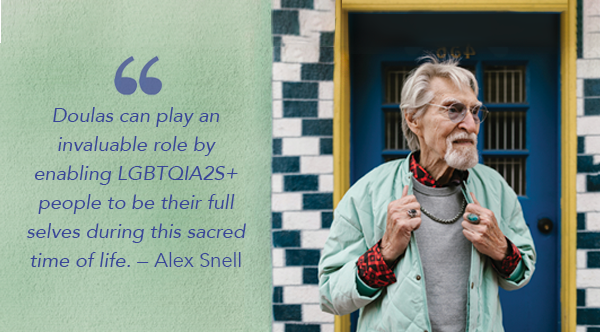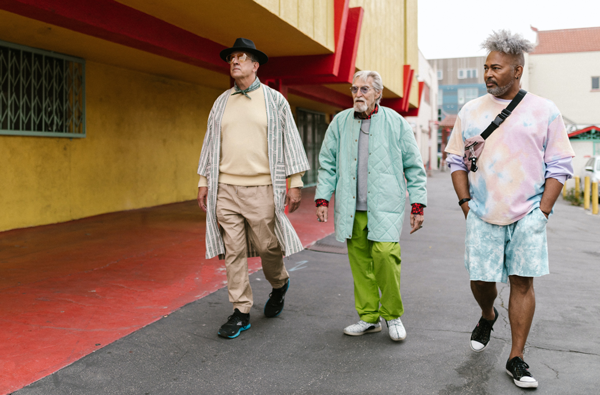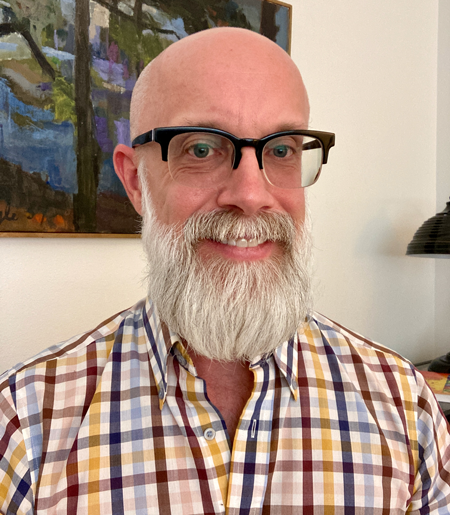Home > Disregarding Assumptions: Care for LGBTQIA2S+ and Nontraditional Families at End of Life
Disregarding Assumptions: Care for LGBTQIA2S+ and Nontraditional Families at End of Life
by Alex Snell


* Names in this article have been changed to protect the identity of individuals.
Christopher was one of my care management clients—a gentle yet feisty queer academic and activist with stage 4 prostate cancer who had begun hospice care. One evening I stopped by his apartment to drop off a prescription while he was dining with his friend John. Christopher’s care circle had informed me about many of Christopher’s friends, but hadn’t mentioned John. Christopher invited me to stay and talk with them. John seemed to be from a different world than that of Christopher’s other friends, who were successful artists and intellectuals. He was a drifter, a bit down on his luck, and projected sexuality. As they showed me photographs of their travels together over the years, it dawned on me that John was Christopher’s boyfriend. I realized I had made assumptions about Christopher’s relationship with his life partner, Niko. But the situation with John did not surprise me.
When I first met with Christopher’s care circle, they said they were glad to have found a care manager who was familiar with unconventional chosen families that often manifest in gay male culture. In 2015, I was inspired to change careers after witnessing the dramatic difference a geriatric care manager made in the quality of life of my friends, a gay couple in their 80s whose care needs had become greater than friends or distant relatives could support. I’ve been privileged to coordinate the care of several of my “gay elders” who needed such help as they aged. I discovered INELDA in 2020 after accompanying a friend through his death, and took the training to learn how to more expansively serve my clients at the end of their lives.
Christopher had no children or other family to assist him through his illness. His care circle consisted of three close friends: Diana, Adam, and Brian. In time, it became evident that Christopher was more of a father figure than friend to Brian, who was deeply distraught about his dying. Christopher’s partner was a very shy artist who lived most of the time in his friend’s home two hours away. Christopher confided that he and Niko were married, which most people, including Adam, did not know. I found it curious that Niko was not part of Christopher’s care circle.
Tragically, many LGBTQIA2S+ people, especially older adults, have been shamed and ostracized by their biological or adoptive families. Born in Idaho, Christopher grew up in an environment that was hostile to an artistic and sensitive boy, and he remained estranged from his biological sister and brother for most of his life. One way in which LGBTQIA2S+ people have responded to disparagement or rejection from their families of origin is by creating “chosen families”—a close-knit network of friends they can rely on for emotional and practical support. Diana, Adam, Brian, Niko, and John were Christopher’s chosen family. Since LGBTQIA2S+ people have an outsider perspective on the expectations of our heteronormative culture, there’s a marvelous freedom and creativity in the different forms that chosen families can take. Being in monogamous couples and nuclear families are options, not an ideal.
As doulas, we become intimately involved with a dying person’s family. An open and supportive approach to working with nontraditional families is a special gift that doulas can offer LGBTQIA2S+ clients. The incredible vulnerability of being seriously ill, in long-term care, or at end of life forces many LGBTQIA2S+ people back “in the closet” as protection from discrimination in hospitals, hospice, and residential care facilities. Doulas can play an invaluable role by enabling LGBTQIA2S+ people to be their full selves during this sacred time of life.
Some nontraditional family situations you may encounter in working with LGBTQIA2S+ people are polyamorous families, family bonds through children, estrangement from families of origin.
Polyamorous families
Polyamory is the practice of having intimate relationships with multiple people at the same time. It’s been estimated that 4% to 5% of people in the United States are polyamorous; polyamory is more prevalent among younger generations. One way of thinking about polyamory that I find beautiful is that we all have an infinite reservoir of love to give one another. For some people, that abundance is shared through more than one committed romantic relationship. Polyamorous families can take shape in a variety of ways, but the essential quality they all share is consent. Polyamory is sometimes referred to as ethical or consensual nonmonogamy, since everyone involved has consented to the other relationships their partners are in. Polyamorous relationships are found among straight and queer people alike.
As you might imagine, navigating emotional dynamics within polyamorous families takes some work. I was contacted by the husband of a man with early-stage Alzheimer’s who had become too frail to be left alone. The client also had a boyfriend, who himself had a boyfriend. The client and his husband had an “open relationship,” in which the husband was free to pursue other sexual and romantic relationships. All four lived on the same property. Ultimately, I did not accept this family as a client, because the degree of conflict between the four men was more than I could manage. Know your own ability to handle complex relationships.
Another form of polyamorous family that is not uncommon among LGBTQIA2S+ people is a “throuple,” in which three people are in a mutually committed relationship. In a throuple, the relationship between the three people can be equal or hierarchical (for example, a married couple who share a boyfriend).
For doulas working with polyamorous families, our skills in awareness, curiosity, and advocacy are indispensable. Become familiar with different types of polyamorous relationships and common dynamics within them (the book Polysecure is a great resource). Awareness can make a situation such as when I met Christopher’s boyfriend John less unexpected. It provides insight into how and when to approach conversations about these relationships with the dying person. Awareness also enables you to signal acceptance and nonjudgment about polyamory, opening a door to the true nature of relationships with people who might be presented as friends.
Working with a polyamorous family may bring a new dimension to the cultural humility that is the essence of our practice. Doulas become skilled in reflecting on any discomfort a client’s beliefs or situation may prompt in us, and we are changed by each death experience we participate in. Thoughtful curiosity about the nature of a client’s polyamorous relationships at end of life is a wonderful affirmation of who they are and how they love. Be sensitive to your client’s comfort level with talking openly about their relationships as you consider helping them explore and find meaning.
Although the prevalence of polyamorous families is growing, our social institutions are poorly equipped to accommodate them. Fear of misunderstanding, stigmatization, and mistreatment may make clients wary of people who provide services at end of life. With awareness and understanding, doulas can play a crucial role in helping educate and advocate to hospices, funeral homes, and home aides, as well as friends and family members who may not understand or honor the dying person’s polyamorous family.
Family bonds through children
It’s fairly common for older LGBTQIA2S+ people to have adult children from straight marriages prior to coming out. The children’s relationship with their LGBTQIA2S+ parent can range from loving to accepting to totally estranged. LGBTQIA2S+ parents in this situation may have lingering internal conflict between their desire to embrace their true identity and guilt about how their coming out disrupted their family’s life. An LGBTQIA2S+ dying person may want to explore and come to terms with these issues with the help of a doula. The nature of the person’s relationship with their children and how they fit with their chosen family is an important dynamic to be aware of and prepared to navigate.
I’ll mention another way, which I’ve seen through my own friend group, that LGBTQIA2S+ people can have unique family relationships through children: a married gay friend of mine donated his sperm for his lesbian best friend and her spouse to parent a child. Both men have a relationship with the child.
 Estrangement from families of origin
Estrangement from families of origin
The negative, if not traumatic, experiences many LGBTQIA2S+ people have had with their families of origin often result in strained or severed ties with family members. This can be a double-edged sword for doulas. We often seek to help the dying person heal relationships on their journey toward a peaceful death. For some LGBTQIA2S+ people, the broken bonds with families of origin might be irreparable, and attempting to guide them toward forgiveness could be inappropriate or even retraumatizing. Healing may not be necessary to achieve a satisfying closure. That said, we should not miss opportunities for transformed relationships that end of life frequently presents. Attunement to what your client is seeking is so important.
Even when family ties have been maintained, LGBTQIA2S+ people may not be fully out to all family members. Doulas can respect and help preserve the confidentiality of the client’s sexual identity when appropriate, and alternatively help them explore feelings around coming out.
The unfortunate reality is that family members who have disowned an LGBTQIA2S+ relative may reappear at end of life if that relative has valuable assets. If your LGBTQIA2S+ client is estranged from family members who are legal next of kin, it is absolutely essential that they have advance directives, power of attorney, and wills in place that are complete and up to date. Ideally these documents will have been prepared by an attorney.
Prepare for Shifts in Attitudes
When we accompany dying people as they navigate fear, joy, pain, regrets, serenity, healing, and new possibilities at end of life, we witness some powerful transformations in family relationships. This is no less true with LGBTQIA2S+ people and their families, chosen and otherwise. Christopher’s sister and brother arranged their first visit to New York City to spend a few days with Christopher before he died. They reached a new level of understanding and acceptance, and were listed among Christopher’s survivors in his obituary. Because of Adam’s frequent disagreements with Diana and Brian, as well as Christopher’s complaint that Adam’s visits were draining, he was eased out of the care circle.
When I first started working with Christopher, Diana had told me that Niko was so shy and embarrassed of his English-speaking skills that he was unlikely to talk with me. However, I was eventually able to arrange a brief conversation to establish a relationship with him. Soon after, when Diana was telling me about an issue the care circle was discussing, I gently asked about Niko’s perspective. Soon after, I noticed that Niko seemed more included by the care circle. He was spending more time with Christopher in New York, making exquisite dinners and staying with him overnight. At a small gathering following Christopher’s death, I was surprised when Niko came up to me and gave me a bear hug. With emotion he said, very deliberately, “Thank you so much.” Perhaps the most rewarding aspect of my work with Christopher and his family was observing the shift in Niko’s participation in Christopher’s death.
Suggestions for doulas working with LGBTQIA2S+ people and nontraditional families
Gain awareness and education about the unique needs of LGBTQIA2S+ people and their families. Learn about the life experiences of LGBTQIA2S+ people, how they create families for themselves, barriers to end-of-life care, and polyamorous relationships.
Be inclusive with the language you use when talking about your services and in marketing materials. “Loved ones” or “caregivers” may be more appropriate than family. Indicate your own sexuality and gender identity, or list your training in cultural competency such as SAGECare training and others. Include LGBTQIA2S+ client testimonials and case studies.
Practice cultural humility, curiosity, and sensitivity when asking LGBTQIA2S+ people about family relationships.
Advocate and educate service providers on behalf of the dying person and members of their chosen family. Make sure that any resources you recommend are LGBTQIA2S+-inclusive, ideally with staff trained in cultural competency and experience working with nontraditional families.
Prepare to support the chosen family through disenfranchised grief. Our society does not expect or make space for profound grief aside from the traditional family roles of spouse, parent, child, or sibling.

Alex Snell
Bio: Alex Snell, MSW, operates a private care management practice in Palm Springs, California. He completed INELDA’s training in 2020. Alex views his vocation as helping older adults and their loved ones meet the challenges of aging and dying with dignity. He offers particular expertise in Alzheimer’s and dementia care and communication, nontraditional families, and LGBTQ older adults. He earned a master of social work with a focus on aging from Hunter College in New York City in 2015. Prior to his work with older adults, he worked as a digital media strategist for 15 years. Alex also creates programs for Let’s Kick ASS (AIDS Survivor Syndrome) Palm Springs, a community-building organization of long-term survivors of HIV/AIDS.
Alex can be reached at [email protected]
